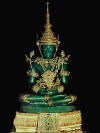|
Emerald Buddha
Name of a 66 centimeter
tall, dark green,
jade-like, jasper
Buddha image
with a lap span of 48 centimeter, housed in
Wat Phra Sr Rattana Sahtsadahrahm in
Bangkok
and regarded as the palladium or guardian spirit of the kingdom. It is considered Thailand's greatest art treasure and enjoys national veneration. According to the seasons
(fig.) it is dressed in different attires (fig.) put on by the king himself, or a
high official representative, e.g. the crown prince. The statue was accidentally discovered when in 1434 AD the octagonal
chedi of
Wat Phra Kaew, a temple in
Chiang Rai
(fig.),
was destroyed by lightening, thus revealing the statue. King Sam Fang Kaen of
Lan Na wanted to
bring the statue to the capital
Chiang Mai,
but the elephant carrying it insisted on going to
Lampang instead, and after three separate attempts
with the same outcome, this was seen as an auspicious sign and the Emerald
Buddha was taken to Lampang instead, where it
remained for 32 years, until 1468, when it was taken to
Chiang Mai by
Phaya
Tilokarat (fig.)
and housed in
Wat
Chedi Luang
(map
-
fig.). When in 1545 Ket Klao,
the king of Chiang Mai was assassinated, he was briefly succeeded by queen
Chiraprapha, who was in 1546
replaced by prince Setthathirat,
the young crown prince of Luang Prabang and son of King Photisarath, the ruler
of the Kingdom of
Lan Chang.
But when 13 months later his father died,
King Setthathirat decided to return to
Laos
to succeed the throne of his father and rule Chiang Mai from
there, taking the Emerald Buddha with him (fig.). In 1564, he moved the statue to the
new capital
Vientiane,
where it stayed until after the conquest of Vientiane
in 1778
AD, when
it was brought to
Thonburi
by general
Chao Phraya
Chakri and initially placed in
Wat Arun,
before being moved to its present location in Wat Phra Kaew, in Bangkok.
Another tradition has it that the Buddhist sage
Nagasena
(fig.)
made the Emerald Buddha,
allegedly the first
representation of the Buddha. According to this legend, the Emerald
Buddha would have been created in India in the first century BC by Nagasena in
the city of Pataliputra, present-day Patna. After remaining there for
three hundred years, it was taken to Ceylon to save it from a civil war. In
order to support Buddhism in his country King Anuruth of
Burma in 457 sent a mission to Ceylon to ask for
Buddhist scriptures and the Emerald Buddha. His request was granted, but the
ship with the statue lost its way in a storm and ended up in
Cambodia,
where it was taken to
Angkor Wat. When the Siamese conquered
Angkor Wat, the Emerald Buddha was taken to
Ayutthaya and later to
Kamphaeng Phet,
then to Laos and finally to Chiang Rai, where the ruler of the city placed it in
a chedi. However, besides being depicted as
one of the 18
arahats, the sage Nagasena is not known
through sources other than the
Milinda Panha
and this legend. Wat
Phreah
Keo in Phnom Penh houses the
Khmer
version of the
Emerald Buddha
(map
-
fig.),
and Wat Mai in Luang Prabang houses a Laotian copy (map
-
fig.), whereas Wat Pa Yia, the
original temple where the image was discovered and later changed its name to Wat
Phra Kaew, today also has a replica Emerald Buddha on display, which is also
referred to as
Phra
Yok
Chiang Rai, i.e. the ‘Chiang
Rai
Jade
Buddha Image’
(map
-
fig.).
See MAP.
回






|

